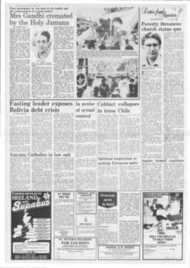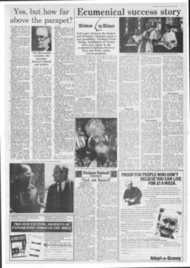Page 5, 9th November 1984
Page 5

Report an error
Noticed an error on this page?If you've noticed an error in this article please click here to report it.
Tags
Share
Related articles
Konig Initiative
Ecumenism Within The Bounds Of Our Loyalties
Arcic Winter
Church Mourns Cardinal König, Architect Of The...
Cardinal Forecasts Unity By Year 2000
Ecumenical success story
Writers in illitre0
Full unity between the Roman and Orthodox Churches seems a real possibility. Cardinal Franz Konig, Archbishop of Vienna and a key figure in the ecumenical dialogue between East and West, charts recent progress.
THE CONTRIBUTION to the ecumenical dialogue offered by Vienna in recent years was favoured by its geographical situation and historical connections. Two facts caused the Archbishop of Vienna and its Archdiocese to turn their attention repeatedly towards the East: my journeys to the Eastern States begun in the early sixties, and Vatican II.
Suggestions made by the Viennese periodical Word and Truth led to the foundation of "Pro Oriente". Through the instrumentality of this ecclesiastical foundation, instituted by me in November 1964, ecumenical relations, especially with Orthodox Christians and among these with the ancient Eastern Churches (Copts, Syrians, Armenians, Ethiopians, Syro-Indians) were resumed. This was principally a matter of lectures, mutual visits and scholarships organised by "Pro Oriente".
Iron Curtain
In those years, because of the so-called Iron Curtain, such an enterprise was exposed to many misunderstandings. However the Popes from John XXIII to John Paul 11 welcomed our undertaking as an answer to the Ecumenical thaw engendered by the Council.
In consequence of this attitude I paid a visit to the Roumanian Patriarch in 1967, which, with due modesty, we can attribute to the special services of "Pro Oriente" in Vienna.
This seems significant, since the attitude of reserve on the part of the Orthodox Church in Roumania towards the Catholic Church was especially marked. "Pro Oriente" undertook all these activities without official authorization, but always in liaison with the Secretariat for the Promotion of Christian Unity. Consequently it was also possible to begin an unofficial dialogue with the Orthodox Churches in 1974.
I believe that in doing so we helped to pave the way for the official dialogue with the fourteen autocephalous or independent Orthodox Churches, which began six years later in 1980.
By the way. the Orthodox Churches had agreed among themselves that they would only begin an official dialogue with the Catholic Church jointly and not separately. It seems to me to be very important that we from Vienna succeeded in making closer contacts with the five ancient Eastern Churches. Since the Council of Chalcedon (451) these five ancient Eastern Churches had withdrawn from the Unity of Christendom.
After detailed discussions in Vienna we came to the conclusion that the contradictions in the
Christological formulae of the schools of Antioch and Alexandria can be rectified today. In consequence of this the reproaches of monophysitism raised on both sides can no longer be upheld in the wording worked out centuries ago. The so-called Viennese Christological formula elaborated during these common "consultations", held between 1971 and 1973, led to those joint declarations signed by the head of the Coptic Church and the head of the Church of Antioch (the Patriarch of Damascus) together with Pope Paul VI in Rome.
At the time the head of the Coptic Church (Papa Shenouda) remarked to Pope Paul VI. "We have had many joint conferences: but we must make special mention of the theological consultations in Vienna between the theologians of the ancient Eastern Churches and the Roman Catholic Church, where a tentative formula concerning the nature of Christ was arrived at and accepted by both sides in September 1971." (cf. Osservatore Romano 7th-8th May. 1973).
Dialogue
Without doubt such a stage was the visit of the head of the Syrian-Orthodox Church, *Mar Ignatius Zakka I. [was, paid to Pope John Paul II in June. The Pope and the Patriarch signed a sensational document, the significance of which is only slowly dawning on many observers. In this document the Roman Catholic Church and the Syrian-OrthOdox Churches agreed upon Communicatio in Sacris.
, The Pope and the Patriarch permitted their faithful to receive the sacraments from a priest of the other Church if none of their-own was available. This covers confession, Holy Communion and the Anointing of the Sick. This is the first agreement concerning Communicatio in Sacris made by the Catholic Church with any other Christian Church.
The background to this is that both Churches had approached each other through• a patient dialogue. In doing so theologians and bishops discovered that there was actually nothing to separate the two Churches.
John Paul II and Mar Ignatius expressly refer to the common content of faith in both Churches: "Today we cannot find any real basis for the deplorable dissensions and tensions between our Churches."
It was a joy to me to be able to greet the patriarch in Vienna immediately after his visit to Rome. It was not the first time that Mar Ignatius had come to Vienna.
In the framework of the unofficial conversations between Catholic and ancient Eastern theologians (the SyrianOrthodox Church belongs to the group of the ancient Eastern Churches) organized by the Viennese Institution "Pro Oriente", Mar Ignatius had been one of the keenest partners in the dialogue before his election as Patriarch of his Church. Still visibly moved by the experience of his fraternal encounter with the Pope, referring to the signing of the joint document concerning Communicatio in Sacris, Mar Ignatius told me on his arrival in Vienna: "Both partners shall now feel that, in spite of slight terminological differences, they are members of the one Church".
As a matter of fact the signing of the document in Rome only puts an official stamp on a discovery made by us in the "Pro Oriente" conversations during honest, open and respectful theological discussions among experts. Actually the Catholic Church and the ancient Eastern Churches are one in faith; in differing theological terms they mean the same thing.
Universality
If is well known that the ancient Eastern Churches had withdrawn from the universal Church in the fifth century after the Council of Chalcedon.
At Chalcedon it was a matter of the central question of Christianity, which moves people — not only theologians — so much again today: Who is Christ? Is He only a great man and teacher? Or is He in truth "the Son of God" as the accounts of the Evangelists express it? And what does that mean? How can Christ be God and man at the same time?
In the fifth century the ancient Orientals doubtless withdrew from the universal Church for cultural, linguistic and last not least for political reasons as well.
The language of the universal Church was Greek. The thinking and theological considerations of the ancient Eastern Churches (to which, apart from the Syrian, the Coptic Ethiopian, Armenian, South Indian Churches belong too) were very strongly characterized by the different linguistic structures and traditions of the Orient.
In the following centuries theological divergences also changed into political dissensions. People drifted apart — brothers in the faith became enemies. It was therefore the immediate aim of the unofficial discussions between theologians, which had taken place in Vienna since the beginning of the seventies "to clear away the rubble", to remove misunderstandings and patiently to listen to each other.
Soon these conversations brought complete agreement concerning faith in Christ as the true God and the true man to light. Here the dialogue with the ancient Orientals could also provide precious assistance in clarifying the topical christological discussion in Western theology.
Encounters
When we Western Catholics encounter the ancient Eastern Churches, we are confronted with the unbroken religious tradition of Christian communities which, in spite of centuries of persecution and all historical catastrophies, have kept their faith in Christ and God made man, as Saviour and Redeemer. In this encounter with the ancient Eastern Churches, above all with the Syrian Orthodox Church, Catholics rediscover to their delight the treasures of an ancient Christian tradition so faithfully preserved in these Churches.
The signing of the document concerning Communicatio in Sacris between the Catholic and the Syrian Orthodox Church shows that there are indeed "success stories" on the way to Christian unity, and that ecumenical disappointment and ecumenical impatience are out of place.
To be sure there is still much to be done about t he relationship between the Catholic and the Syrian Orthodox Church on the way to full Church unity. But the newly won understanding with the Syrian-Orthodox Church shows that honest theological effort, fraternal candour and readiness to discover the will of God in "the signs of the times" can indeed bear fruit.
*Syrian-Orthodox Church: As will become clear later, this is the Church often referred to as Jacobite, which has retained the use of the West-Syrian liturgy, as opposed to that of those in Syria who use the Byzantine liturgy and remain today in Communion with the ecumenical Patriarchate.
blog comments powered by Disqus











